
Daphnis nerii, the oleander hawk-moth or army green moth, is a moth of the family Sphingidae. It was described by Carl Linnaeus in his 1758 10th edition of Systema Naturae.
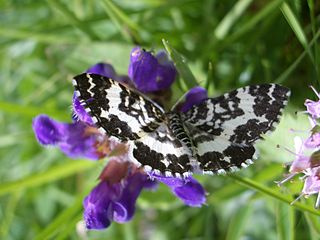
The argent and sable moth is a day-flying moth of the family Geometridae, with distinctive black and white colors. They tend to live on wetlands and hillsides. The larvae spin together the leaves of their food plants to form their cocoons. It was named argent and sable in 1778. Argent and sable refer to the heraldic color names for white and black. Their distribution is Holarctic. The species was first described by Carl Linnaeus in his 1758 10th edition of Systema Naturae.

Hyles euphorbiae, the spurge hawk-moth, is a European moth of the family Sphingidae. This hawk moth is used as an agent of biological pest control against the noxious weed leafy spurge, but usually only in conjunction with other agents. The larvae consume the leaves and bracts of the plant. The species was first described by Carl Linnaeus in his 1758 10th edition of Systema Naturae.
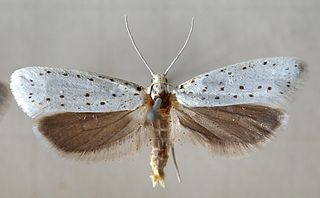
Yponomeuta cagnagella, the spindle ermine, is a moth from the family Yponomeutidae, the ermine moths. The wingspan of the moth ranges from 19 to 26 millimetres. The head is white. Forewings are white; four longitudinal series of few black dots, first not reaching middle, second beginning near before middle, lowest including 4-7 dots; some additional black dots before termen; cilia white. Hindwings are dark grey. The larva is pale greyish-yellowish; spots black; head black.
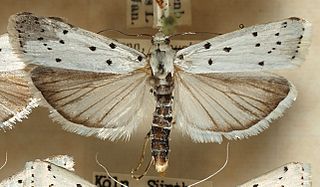
Myelois circumvoluta, the thistle ermine, is a small moth species of the family Pyralidae. It is found in Europe.

Globia sparganii, or Webb's wainscot, is a moth of the family Noctuidae. The species was first described by Eugenius Johann Christoph Esper in 1790. It is found in Europe, Central Asia, from southern Siberia to Manchuria, Korea, Turkey, Syria and Iran.

Lygephila pastinum, the blackneck, is a moth of the family Erebidae. The species was first described by Georg Friedrich Treitschke in 1826. It is found in Europe and across the Palearctic Siberia, the Russian Far East, Japan and China.

Heliothis peltigera, also known as the bordered straw, is a species of moth of the family Noctuidae.

Diaphora mendica, the muslin moth, is a moth of the family Erebidae. It is found in the Palearctic realm east to Lake Baikal.

Spilosoma lubricipeda, the white ermine, is a moth of the family Erebidae. It is found throughout the temperate belt of Eurasia from Europe through Kazakhstan and southern Siberia to Amur Region, China, Korea and Japan. In China several sibling species occur.

Setina irrorella, the dew moth, is a moth of the family Erebidae. The species was first described by Carl Linnaeus in his 1758 10th edition of Systema Naturae. It is found in the Palearctic from Ireland, then through Europe and east to northern and central Asia to the Pacific Ocean. It is missing in the high north and parts of the Mediterranean region. It is found also in the limestone Alps up to 2,000 meters above sea level.
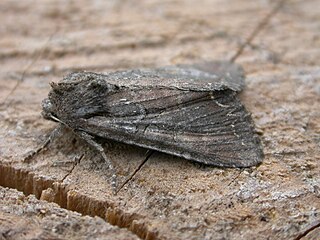
Lacanobia suasa, the dog’s tooth, is a moth of the family Noctuidae. It is found in the Palearctic realm.

Abrostola asclepiadis is a moth of the family Noctuidae. It is found in South and Central Europe as far north as Finland and Sweden, Asia Minor and the Caucasus.

Eudocima materna, the dot-underwing moth, is a moth of the family Erebidae found in widespread parts of the world, mainly in tropical Asia extending to New Guinea and Australia as well as in Africa. Reports from the United States, Canada and the French Antilles are now considered to be Eudocima apta. The species can be differentiated from other Eudocima moths by the presence of small central black dot in each hindwing. The species was first described by Carl Linnaeus in his 1767 12th edition of Systema Naturae.
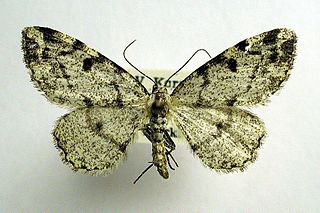
Alcis jubata, the dotted carpet, is a moth of the family Geometridae. The species was first described by Carl Peter Thunberg in 1788. It is found in central Europe, Scandinavia and northern Italy.
Paraplatyptilia carolina is a moth of the family Pterophoridae described by William D. Kearfott in 1907. It is found in the southeastern United States, including Florida, southern Mississippi, North Carolina and Georgia.

Agonopterix yeatiana is a moth of the family Depressariidae. It is found in most of Europe.

Sideridis turbida, the white colon, is a moth of the family Noctuidae, subfamily Hadeninae. It is found throughout continental Europe, the British Isles and southern Scandinavia.

Carpatolechia notatella, the sallow-leaf groundling, is a moth of the family Gelechiidae. It is found in most of Europe and Turkey.

Exoteleia dodecella, the pine bud moth, is a moth of the family Gelechiidae. It is widely distributed from western Europe to Siberia. It is an introduced species in North America.


















